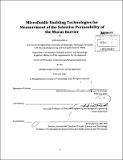Microfluidic enabling technologies for measurement of the selective permeability of the mucus barrier
Author(s)
Li, Leon Daliang
DownloadFull printable version (12.87Mb)
Other Contributors
Harvard--MIT Program in Health Sciences and Technology.
Advisor
Jongyoon Han.
Terms of use
Metadata
Show full item recordAbstract
Mucus is a biological hydrogel which lines the wet (non-keratinized) epithelia of the body. Mucus provides a gateway between the cells of the epithelium and the outside world, and is postulated to provide a selective filtering function which is critical to physiological functioning and has been implicated in diseases. Currently, much of the mechanisms and criteria of this selective filtering function is not well understood. In this thesis, we contribute novel microfluidic devices to characterize the selective permeability properties of the mucus barrier. Microfluidics provides the engineering ability to create channels with precise geometries, fluid flow capability, and allow chemical concentration gradients. Our devices mimic the physiological environment of the mucosa and enable improved measurements of the mucus layer selective permeability. The first microfluidic device mimics the acid barrier function of the stomach mucus layer. This device reproduces on-chip the secretion of mucus by the gastric mucosa into an acidic stomach lumen. We use this device to demonstrate that the secretion of mucins, the glycoprotein structural component of mucus, contributes significantly to the acid barrier function by continuously binding H'. The second microfluidic device probes the permeability of the mucus barrier to nanoscale peptides, as a model for drug molecules and in vivo signaling molecules. The device enabled the creation of a mucus layer next to a flowing aqueous layer, mimicking the in vivo mucus layer and lumen of the gastrointestinal, respiratory, and female reproductive tracts. Peptides added to the aqueous flow diffused across the mucus barrier interface into the mucus layer. This device demonstrated that the mucus barrier provides selective permeability to nanoscale peptides based on electrostatic interactions, and suggest novel surface functionalization strategies for drug carriers to improve mucosal drug delivery. Taken together, this thesis provides new microfluidic tools to probe the selective permeability function of the mucus barrier. Using the microfluidic tools, we show new mechanistic understanding of this barrier.
Description
Thesis (Ph. D. in Electrical and Medical Engineering)--Harvard-MIT Program in Health Sciences and Technology, 2013.. Cataloged from PDF version of thesis. Includes bibliographical references (p. 64-72).
Date issued
2013Department
Harvard University--MIT Division of Health Sciences and TechnologyPublisher
Massachusetts Institute of Technology
Keywords
Harvard--MIT Program in Health Sciences and Technology.